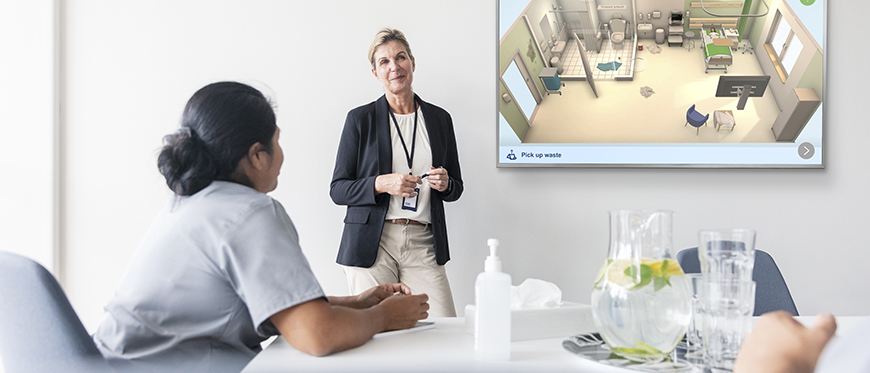Proper cleaning and its positive impact on patient safety in hospitals remain as important as ever. A new online tool can help you prepare your environmental services and cleaning staff to meet this priority: the Tork® Interactive Clean Hospital Training.
In a remote, easy-to-use, and visual way, the online training educates environmental service professionals on how to implement a hygienic and safe healthcare environment. Users enter an interactive patient room to learn and practice the right cleaning strategies. At the end of the training, users are also scored on their efforts and results show how well staff have identified and cleaned the high-touch surfaces in the patient room.
The training is based on the Association for the Health Care Environment’s (AHE) Practice Guidance for Health Care Environmental Cleaning, the go-to resource for best-in-class tools, products, education and training. The training also reinforces cleaning guidelines from the CDC, OSHA, EPA, and other regulatory and government agencies. The exercises aim to ensure that environmental service professionals and their staff carry out tasks according to these recommendations.
The training format and structure
- Gather your team in a room equipped with a large screen or monitor. 10 to 20 employees at a time is preferable.
- Access the Tork Interactive Clean Hospital Training online.
- Invite participants to go through the training and then reflect on their score.
- Leave time for questions and discussion.
Reinforcement of key cleaning approaches
Before staff enter the virtual patient room, the training reinforces key points about cleaning:
- Clean high to low: If a room is cleaned high to low, the potential risk to re-contaminate already cleaned surfaces decreases dramatically.
- Cleanest to dirtiest: Start with the cleanest areas and then move to the dirtiest areas. Restrooms are typically the dirtiest part of a patient room and should be cleaned last.
- Clockwise or counter-clockwise. Plan a logical and methodical cleaning pattern.
- Hand hygiene: Hand hygiene should be performed before or after entering the patient room, before and after donning PPE, before and after patient contact, and after contact with blood, body fluids, or contaminated surfaces.
Two situations for cleaning a patient room
The training also walks staff through the cleaning steps and tasks for two situations: 1) in an occupied patient room, and 2) after the patient is discharged. Staff will be asked to perform a wide range of tasks with their cursor that simulate what they will need to do in their jobs – from removing waste and disinfecting an area to cleaning a bathroom.
Steps for cleaning an occupied room:
- Preparation
- Remove waste
- Remove linens
- Spot clean walls
- Damp wipe
- Disinfect
- Clean bathroom
- Restock consumables
- Damp mop
Steps for discharge cleaning:
- Practice how to remove waste
- Remove linens
- Remove high dust
- Spot clean walls
- Damp wipe
- Clean windows
- Disinfect
- Clean bathroom
- Restock consumables
- Damp mop
- Remake bed
Tips to engage your staff in training
The Tork Interactive Clean Hospital Training is designed to make it easy for you to engage your cleaning staff. Additional tips include:
- Make the training a team activity or game. Separate participants into teams and compare their total team scores from training.
- Highlight additional cleaning ideas. For example, a section on removing waste says, “Use caution and look for protruding objects in the waste bag or container.”
- The training is available in many languages. Use the one most relevant to your staff.
- Have each participant access the training on their own phone, tablet, or computer.
- Hand out downloadable diplomas to your team!
Sign up and experience the Tork Interactive Clean Hospital Training yourself today.
